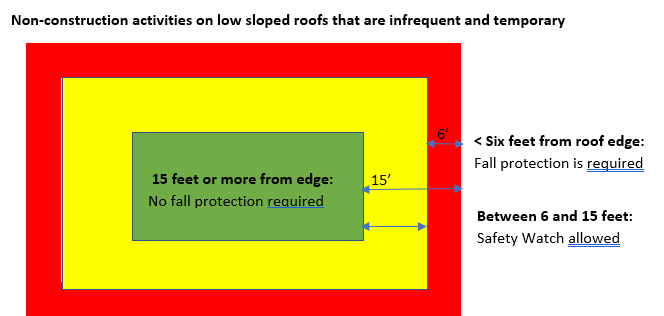UW personnel who work at heights, where there is a potential to be exposed to a fall to a lower level, should read and understand the key changes to the Washington Administrative Code Unified Safety Standards for Fall Protection (WAC 296-880) that became effective on November 1, 2022.
UW personnel must be aware of the following significant changes.
Trigger height change
The trigger height where fall protection is required was reduced to 6 feet for construction activities that involve
- Roofing work on low sloped roofs; and
- Construction of a leading edge.
Non-construction activities on low slope roofs
Requirements for non-construction activities on low slope roofs when work is infrequent or temporary has changed to include:
- New definitions of “infrequent” and “temporary,” which include work that is not routine and is brief or short in duration (e.g., troubleshooting)
- A Safety Watch is allowed as alternate fall protection when working at distances greater than 6 feet and less than 15 feet from the unprotected roof edge.
- If work can take place at 15 feet or more from the edge, and it has been communicated to the employee that they are prohibited from approaching the unprotected edge, no fall protection is required.

Safety Watch
Clarifications on Safety Watch requirements include:
- Only to be used on low slope roofs during non-construction work activities when the task is infrequent and temporary and takes place at least six feet from the edge.
- Involves one appointed employee watching another employee perform work and warning them if they breach this distance.
- The Safety Watch must be designated as a “competent person,” meaning they are knowledgeable about fall protection, can recognize fall hazards, have the authority to intervene, and more.
- The Safety Watch must also maintain a clear view of the worker and be able to be heard above any environmental noise.
- If additional workers are required, there must be an appointed Safety Watch equal to the number of additional workers.
- A Safety Watch cannot be used for construction work.
- Refer to the updated Using Alternate Fall Protection on Roofs focus sheet for details.
The key takeaway is when performing any kind of roofing work, personnel and their supervisors should evaluate each occurrence independently, as a new or non-routine activity, where a hazard assessment is required. The UW Roof Access Permit and Fall Protection Work Plan template are tools available to help you conduct and document a hazard assessment and identify safe work practices to reduce your risk of falling when working on low sloped roofs.
Washington State Department of Labor & Industries (L&I) Division of Occupational Safety and Health (DOSH) updated the Unified Fall Protection Rules in response to OSHA’s notification that the Washington rules did not meet the requirement for the state’s rule to meet or exceed the federal fall protection regulations.
Visit the Fall Protection webpage for more information and links to fall protection tools and resources.